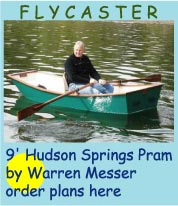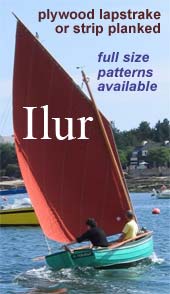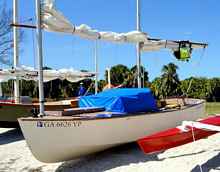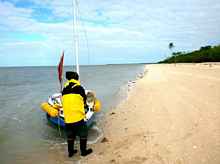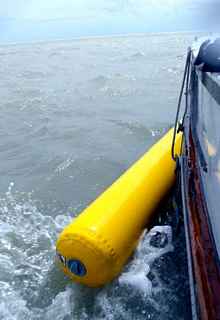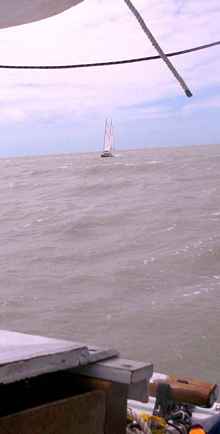
 Custom Search
|
| boat plans |
| canoe/kayak |
| electrical |
| epoxy/supplies |
| fasteners |
| gear |
| gift certificates |
| hardware |
| hatches/deckplates |
| media |
| paint/varnish |
| rope/line |
| rowing/sculling |
| sailmaking |
| sails |
| tools |
| join |
| home |
| indexes |
| classifieds |
| calendar |
| archives |
| about |
| links |
| Join Duckworks Get free newsletter CLICK HERE |
|
|
| EC 2016 - Part Three |
by Gary and Helen Blankenship, Tallahassee, Florida - USA
|
Part One - Part Two - Part Three - Part Four At 2:15 p.m., we were off. In the December trip, we had scouted the best route from Chokoloskee Island across the bay on the south side to the mangrove islands and Rabbit Key Pass. That, with some help from Google Earth, got us across. We bumped on a shoal once and I overshot one turn, but we made it to the mangroves with little hassle. Unfortunately, the mangrove islands were oriented to block much of the strong wind, and we more or less drifted through the pass.
But about an hour after leaving we reached the open gulf. I cut south a bit sooner than the charts indicated might be prudent, but the leeboard only bumped a couple times. As Oaracle approached Pavilion Key the seas became very short and choppy, as they had the two previous times I had been here in strong east to south winds. We were averaging about 4 knots, but Oaracle was being tossed around like a leaf in a gale. Pavilion juts out into the gulf; once past it, the coastline veers east about four miles, while the shortest course to Cape Sable is about 155 degrees. In strong easterlies, that leaves boats exposed to quite a chop. Since our total sleep at this point was four to five hours plus a couple short naps the previous day, both Gary and I were very tired. We took a couple tacks to close with Pavilion to cut down on the wave action, then sailed past the island for an about an hour, making 5 knots. Then it was a long tack back to shore, as the sun set behind us, to get out of the sloppy seas. I had decided that given the rough conditions and our tiredness, we would go to Lostmans River, about halfway to Cape Sable, stop for the night, get some real rest, and tackle the rest of the bashing to the Cape and then to Flamingo when we had more energy. We reached the coast and headed south again, just able to stay parallel to the shore without tacking. Then about an hour or so later, we got a lucky break. The wind eased to about 10 knots and the seas, both from the proximity to the shore and the lighter breezes, went down. We were still doing hour on, hour off turns at the tiller but now with the more benign conditions, the off watch person could go in the cabin and stretch out. I left the double reef in because of the forecast high winds and we didn’t want any gusts hitting with on person below. The speed eased first to about 3.5 knots and then 3 knots, but at the moment rest was more important than speed. The planned stop at Lostmans River was abandoned. I don’t know how Gary did, but I got about four hours of sleep on my turns below deck and got to feel reasonably rested. We later talked to Graham Brynes (Roo) of B and B Yacht designs who stayed two or three miles offshore that night; he reported that both the winds and seas remained high. Before dawn, the wind went perhaps a bit lighter and both reefs came out of the sail – I was sure that was only temporary. By 5 a.m., we made it to Northwest Cape Sable and the wind went lighter with Oaracle making a bit over 2 knots. It took two hours, until sunrise, to make Middle Cape. The wind picked up a bit. We cut it a bit close by Middle Cape, and the leeboard kicked partway up. I made a mental note to put it back down when we hit deeper water. Not too much farther, Gary spied a boat near shore and ahead of us. “That looks like Bandaloop,” he said, referring to the Core Sound 17 owned by John Bell (MisterMoon) and which he was sailing this year with Will Nye (ZerotheHero).
It can be revealed now that Gary and I had a secret goal this year beyond my standard to aims of 1) not dying and 2) finishing. That was to get to Key Largo ahead of Bandaloop. Alas, I think they were the first Class 4 boat in the water at the start and we hadn’t see them since. I called John on the radio and he relayed they had gotten to East Cape Sable the previous night, rounded it in the strong winds but hit and outgoing tide and hadn’t been able to make any progress. So they retreated to the beach just north of Middle Cape, pulled Bandaloop clear of the water, and camped – but setting up the tent some ways from the trail left by a large crocodile in the sand. John now calculated the tide would be favorable. So, game on with Bandaloop! Or not. As we both headed south, they hugged the shore while we slipped a bit sideways. I was baffled for a while and then remembered – the leeboard! Sure enough, it was all the way up and we were making generous leeway. We tacked to get back close to shore while John and Will rounded East Cape and disappeared. At the same time, Bill Fite (Jarhead) came up in his Sea Pearl. Bill was in the longer 1,200-mile Ultimate Florida Challenge, which he had extended by another 400 miles by starting from the Alabama state line a week or so before the EC began. The wind was picking up in earnest now so just before clearing East Cape, we beached to tie a double reef in. I took particular care since I suspected, correctly, there would be no further sail changes until the finish. Gary reminded me to take some pictures of our stop, the first time I had sampled the excellent beaches at Cape Sable.
We left, with Jarhead in close proximity, and sailed past East Cape. Bill elected to tack quickly and hug the shore as he headed eastwards toward Flamingo. We elected to sail across the mouth of Florida Bay before tacking. After a couple tacks, it seemed Bill had made the right choice; at least he seemed to be far ahead of us. It was a replay from 2012 when John Wright and I had a long, rough, splashy beat from the cape to CP3. But we were making decent time. We tacked north almost to the shore, and then south again almost to First National Bank (I love these names). A couple short tacks got us around Middle Ground Shoal and then we had a long tack back to the mainland. About two and a half hours after rounding the cape, we were about halfway to Flamingo – and we somehow were up with Jarhead again. Bill explained later that he has missed a tack and wound up getting blown into the mangroves along the shore. About the same time, we noticed the beach roller lashed on the port side of the cabin topsides had come loose. Another Deja vu from 2012. That year, I had used ordinary fenders as launching rollers and had three each lashed along the port and starboard cabin topsides.
On the tough beat to Flamingo that year, all three fenders on the starboard side had been washed off and lost. This year, I made sure the rollers had an extra line tied to the foredeck cleat and we took care with the lashings to the cabin sides. When we made it to Flamingo and examined those lashings, they were all in place. Apparently the roller, when we weren’t looking, had contrived to slide out forwards while we were beating in the rough water. For now, it merrily bounced along beside Oaracle, apparently harmless except for splashing some extra spray into the cockpit while on port tack. As we got closer, the deep water channel narrowed, so we were short tacking now. We were slightly ahead of Bill when we first crossed, and to my surprise maintained and slightly extended that margin. Looking at our track, our tacking angles were very good, so John Bell was correct about having a favorable tide.
We passed Murray Key and finally spotted the outer marker for the channel to Flamingo. A short tack at the channel end in front of the seawall brought us to the sheltered entrance to the marina basin, where we dropped sail and then rowed to a dock. We arrived about 1:50 p.m., four hours after passing East Cape. Bill arrived a few minutes later, followed a short while later by Graham, whom Gary has spotted further offshore and slightly behind us when we rounded Cape Sable. We joined John and Will on Bandaloop. Coastie and ClamCounter, on their Hobie catamaran Miss Marie were also here, as were some kayakers. (Interesting note: there were 25 class 4 boats in the EC and the longer UF; of those only eight made it to Key Largo. Four of those boats were now together at Flamingo. Also, both Class 4 UF boats that made it to Flamingo, Jarhead and Doooobrd (Donald Polakovics), finished the UF.) Gary and my immediate priority was to dry out; ourselves, clothes, and some gear that had gotten wet or damp on the long beat from Cape Sable.
We decided not to leave until sometime Wednesday so we could get at a good night’s sleep – the four to five hours we had Sunday morning was still our longest unbroken rest. In retrospect, as will be explained in a bit, this was probably a mild mistake. But we were also able to take (cold) showers, eat dinner at the modest restaurant at the park, and enjoy the extended visit from two manatees grazing in front of Oaracle on the grass growing on the floating dock. The obligatory sacrifice was made to the mosquitos when they put in a brief, but intense, appearance in the evening, and we got our sleep. Third Leg perspective from a first timer: Upon departing Chokoloskee we made our way through Rabbit Key Pass. Again, a truly beautiful part of Florida that only a lucky few get to see. It seemed like in no time we were greeted again by the open gulf and making our way south again. We managed to wake up a few manatees which created a massive churning in the water. The sailing was again smooth and we were making good progress. To negotiate Pavilion Key, we sailed well out into the gulf such that by the time we were headed back inland the sun was setting and darkness was upon us. I cannot truly describe the night sky that night. Without any input from man-made light the sky was simply stunning and my eyes moved from the GPS to the sky over and over again. This was not an easy sail and sleep as hard to get but we traded off at the helm and did the best we could. One of my few regrets of the challenge was that once we were back near the coast we were sailing in darkness and passed much of this unspoiled part of Florida without resting eyes on it. By early morning we were nearing the bottom of Florida. With some light we could see that we were back in the company of fellow Watertribers and we even had a short radio conversation with our friend Mister Moon. After rounding several capes, we headed toward Flamingo and the third checkpoint. This became 6 or 7 hours of wet, choppy seas where we spent lots of time getting splashed with saltwater and making slow progress. One of the two rollers that we used to launch at the start of the race came loose we watched it bob along next to us for several house and dammed if it was not the one I had “secured.”. We finally sailed into Flamingo in the early afternoon. We secured the boat into a slip and stepped on to land. It felt good and we were glad to be there. Theoretically, we were three quarters of the way to the finish, we were still alive, nothing had broken, no one went overboard, and best of all Gary seemed glad to have me on board still. We got a meal and then what we really needed… rest. A full night’s sleep. Nearly eight hours of shut-eye. Welcome sandman. I will provide a bit of customer input to the fine folks who run/manage Flamingo. At the store they offer showers in a private room for $3. That’s nice until they inform you that the showers have no hot water. This is on par with a restaurant serving a nice miso soup but informing you that they never bothered to order any spoons. You just want to kick someone’s rear end. Really? OK, here is my suggestion: Charge $5 and go and buy a water heater. Make it $6 and I am still ok but for the love of all that is holy, get some hot water. |
To comment on Duckworks articles, please visit one of the following:
|
 |
